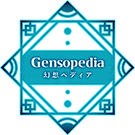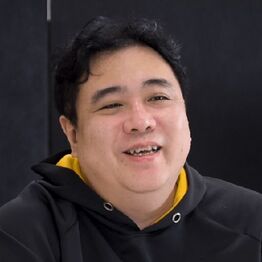More languages
More actions
mNo edit summary |
|||
| (5 intermediate revisions by the same user not shown) | |||
| Line 9: | Line 9: | ||
==History== | ==History== | ||
===University=== | ===University=== | ||
Murayama loved fantasy and ensemble | Murayama loved fantasy and ensemble pieces and was a voracious reader since his university days. His favorite works were those that depicted the existence of varied perspectives and values, and how people thought about and acted on their values. This would become a recurring theme in much of his work. | ||
He would finish his computer programming studies at the University of Tokyo in the summer of 1992. | He would finish his computer programming studies at the University of Tokyo in the summer of 1992. | ||
| Line 16: | Line 16: | ||
Following graduation, Murayama visited [[Konami]]'s newly opened Tokyo headquarters to submit his first job application whereupon he was hired. Initially hired for QA and menial tasks, he was handpicked six months later along with a few others to create his own launch game for an internally developed video game console, where he began collaborating with fellow-newcomer designer [[Kawano Junko]]. This game was scrapped in the early stages of development. | Following graduation, Murayama visited [[Konami]]'s newly opened Tokyo headquarters to submit his first job application whereupon he was hired. Initially hired for QA and menial tasks, he was handpicked six months later along with a few others to create his own launch game for an internally developed video game console, where he began collaborating with fellow-newcomer designer [[Kawano Junko]]. This game was scrapped in the early stages of development. | ||
Murayama, Kawano and ten other employees were instead assigned with developing Konami's first games for Sony's upcoming console, the PlayStation. With the pick of making a baseball game, a racing game or an RPG, Murayama and Kawano decided to | Murayama, Kawano and ten other employees were instead assigned with developing Konami's first games for Sony's upcoming console, the PlayStation. With the pick of making a baseball game, a racing game or an RPG, Murayama and Kawano decided to once again work on an RPG project, although Murayama has stated that given the opportunity, he would have preferred to make a shoot 'em up. | ||
===Suikoden series=== | ===Suikoden series=== | ||
{{Quote | I believe | {{Quote | I believe the world of Genso Suikoden, born from my imagination and shaped by the experiences of many, truly comes to life when you, the player, feel something meaningful through it. | Murayama Yoshitaka, 1998}} | ||
[[File:Murayama Yoshitaka (1996).png|220px|thumb|left|Murayama Yoshitaka c.1996]] | [[File:Murayama Yoshitaka (1996).png|220px|thumb|left|Murayama Yoshitaka c.1996]] | ||
Committed from the start to make a franchise to rival series such as Dragon Quest or Final Fantasy, Murayama wrote the scenario of the first Suikoden. Unimpressed with their early 3D modeling tests, he opted to make a traditional 2D RPG using sprite graphics. In the winter of 1993, he would begin pitching his idea of an RPG with a great gallery of supporting characters. | Committed from the start to make a franchise to rival series such as Dragon Quest or Final Fantasy, Murayama wrote the scenario of the first Suikoden. Unimpressed with their early 3D modeling tests, he opted to make a traditional 2D RPG using sprite graphics. In the winter of 1993, he would begin pitching his idea of an RPG with a great gallery of supporting characters. | ||
Inspired by his preference for manga such as Fist of the North Star and Captain Tsubasa Murayama instead decided to use the classic Chinese novel ''[[Shui Hu Zhuan]]'' in order to better illustrate his point. The pitch was a success, and in this short meeting the game was given the name ''Suikoden'', the Japanese reading of Shui Hu Zhuan, and Murayama was tasked with making 108 characters mirroring the 108 outlaws in the Chinese classic. | Inspired by his preference for manga with strong ensemble casts such as Fist of the North Star and Captain Tsubasa, Murayama instead decided to use the classic Chinese novel ''[[Shui Hu Zhuan]]'' in order to better illustrate his point to his older superiors. The pitch was a success, and in this short meeting the game was given the name ''Suikoden'', the Japanese reading of Shui Hu Zhuan, and Murayama was tasked with making 108 characters mirroring the 108 outlaws in the Chinese classic. | ||
[[Suikoden]] was released in Japan in December 1995 to positive reviews and soon garnered a dedicated cult following. Murayama personally responded to each and every fan letter that was sent. Konami was also intent on making Suikoden into a franchise, and he was asked to develop its sequel, bringing back most of the team from the first game. | [[Suikoden]] was released in Japan in December 1995 to positive reviews and soon garnered a dedicated cult following. Murayama personally responded to each and every fan letter that was sent. Konami was also intent on making Suikoden into a franchise, and he was asked to develop its sequel, bringing back most of the team from the first game. | ||
Latest revision as of 15:41, 13 December 2024
Murayama Yoshitaka (村山 吉隆, 1969 - February 6, 2024) was a game designer, director, and producer. He was the creator of the Suikoden series of JRPGs, which he produced and directed for Konami until his departure in 2002. He was the producer, writer, and director for the upcoming Eiyuden Chronicle: Hundred Heroes.
History
University
Murayama loved fantasy and ensemble pieces and was a voracious reader since his university days. His favorite works were those that depicted the existence of varied perspectives and values, and how people thought about and acted on their values. This would become a recurring theme in much of his work.
He would finish his computer programming studies at the University of Tokyo in the summer of 1992.
Early career
Following graduation, Murayama visited Konami's newly opened Tokyo headquarters to submit his first job application whereupon he was hired. Initially hired for QA and menial tasks, he was handpicked six months later along with a few others to create his own launch game for an internally developed video game console, where he began collaborating with fellow-newcomer designer Kawano Junko. This game was scrapped in the early stages of development.
Murayama, Kawano and ten other employees were instead assigned with developing Konami's first games for Sony's upcoming console, the PlayStation. With the pick of making a baseball game, a racing game or an RPG, Murayama and Kawano decided to once again work on an RPG project, although Murayama has stated that given the opportunity, he would have preferred to make a shoot 'em up.
Suikoden series
|
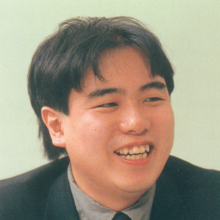
Committed from the start to make a franchise to rival series such as Dragon Quest or Final Fantasy, Murayama wrote the scenario of the first Suikoden. Unimpressed with their early 3D modeling tests, he opted to make a traditional 2D RPG using sprite graphics. In the winter of 1993, he would begin pitching his idea of an RPG with a great gallery of supporting characters.
Inspired by his preference for manga with strong ensemble casts such as Fist of the North Star and Captain Tsubasa, Murayama instead decided to use the classic Chinese novel Shui Hu Zhuan in order to better illustrate his point to his older superiors. The pitch was a success, and in this short meeting the game was given the name Suikoden, the Japanese reading of Shui Hu Zhuan, and Murayama was tasked with making 108 characters mirroring the 108 outlaws in the Chinese classic.
Suikoden was released in Japan in December 1995 to positive reviews and soon garnered a dedicated cult following. Murayama personally responded to each and every fan letter that was sent. Konami was also intent on making Suikoden into a franchise, and he was asked to develop its sequel, bringing back most of the team from the first game.
Deciding what aspects to focus on for Suikoden II, response from the fans prompted them to concentrate on further developing the world and its characters over the graphics and mechanics. The game was released in December 1998, like its predecessor to positive reviews and slow but steady sales.
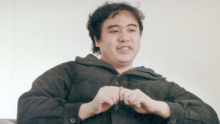
A third game in the series was developed, with Murayama conceiving of the Trinity Sight System in order to address what he perceived as a flaw in previous iterations: As the protagonist's story is usually the focus, the antagonist's point of view is rarely expressed fully or their motivations elaborated upon. Allowing players to experience the same events from multiple perspectives and draw their own conclusions was a key goal.
A month before the release of Suikoden III in July 2002, Murayama left Konami. In compliance with Konami company policy, his name was taken out of the credits for the game. The reason for his sudden departure has been long theorized on by fans, many believing corporate meddling to be the reason, in part because of the omitted credit for Suikoden III.
In an interview with Swedish gaming magazine LEVEL in August 2009, Murayama clarified that Konami had given him great creative freedom as regards Suikoden III and that he had left only because it had been exactly ten years since he was first hired by Konami, and his personal goal had always been to stay no longer than ten years before turning freelance.
Post-Konami
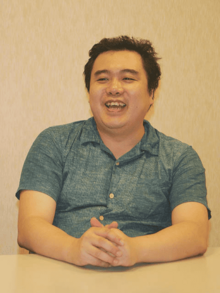
After leaving Konami, he immediately set up his own company, Blue Moon Studio, that later released the game 10,000 Bullets. He also worked on a manga adaptation of Laura Resnick's Magic: The Gathering novel The Purifying Fire with artwork by Himori Yoshino. Murayama also continued to work in games, writing for Japanese visual novel Tensho Gakuen Gekkoroku as well as being credited for the scenario in the 2017 JRPG, The Alliance Alive.
He then went on to reunite with Kawano Junko and other contributors to the Suikoden franchise for a new project which echoed its legacy: Eiyuden Chronicle: Hundred Heroes. The game was announced on July 27, 2020, and launched a successful Kickstarter campaign, making its base funding requirements in just over 3 hours.
Murayama passed away on February 6, 2024 due to complications with an ongoing illness, less than three months before the release of Eiyuden Chronicle: Hundred Heroes. His passing was announced on February 14.
Works
| Game | Role | Releases | Platform |
|---|---|---|---|
| Suikoden | Producer, writer, director | 1995 | PlayStation |
| Suikoden II | Producer, writer, director | 1998 | PlayStation |
| Genso Suikogaiden Vol.1 | Writer | 2000 | PlayStation |
| Genso Suikogaiden Vol.2 | Writer | 2001 | PlayStation |
| Genso Suikoden Card Stories | System programmer | 2001 | Game Boy Advance |
| Suikoden III | Producer, writer, director (uncredited) | 2002 | PlayStation 2 |
| 10,000 Bullets | Producer, writer, director | 2005 | PlayStation 2 |
| Tensho Gakuen Gekkoroku | Writer | 2006 | PlayStation 2 |
| The Alliance Alive | Scenario | 2017 | Nintendo 3DS |
| Eiyuden Chronicle: Rising | Supervisor | 2023 | Microsoft Windows, PlayStation 4, Xbox One, Xbox Series X, PlayStation 5, Nintendo Switch |
| Eiyuden Chronicle: Hundred Heroes | Producer, writer, director | 2024 | Microsoft Windows, PlayStation 4, Xbox One, Xbox Series X, PlayStation 5, Nintendo Switch |
Social Media
- @BmsMurayama on Twitter
